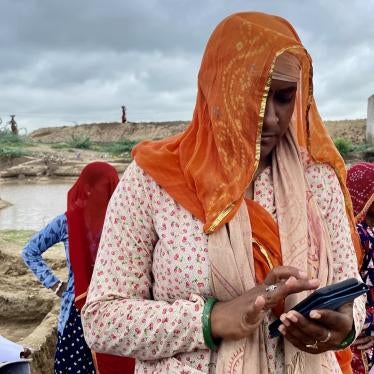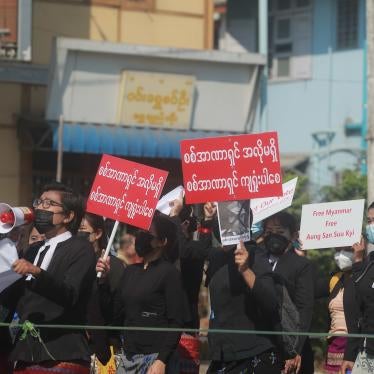(New York) – Restrictions on news, media, and communications in Tibet have been stepped up by Chinese authorities in the lead-up to the 18th Party Congress, due to take place in late 2012.
The measures appear to be an effort to cut off Tibetans in China from news not subjected to the government’s domestic monopoly on information. They are presented officially as an attempt to prevent the views of the exiled Dalai Lama and his followers from reaching Tibetans inside China, particularly those living in rural areas.
The new restrictions, described in the official Renmin Wang media outlet on May 31, 2012, as key to maintaining stability and national security, aim to “ensure the absolute security of Tibet’s ideological and cultural realm,” according to Tibet Autonomous Region (TAR) Party Secretary Chen Quanguo in a June 27 interview. The measures involve significantly increased controls, particularly in the TAR, on internet use, text messages, phone ownership, music publishing, and photocopying, as well as intensified government propaganda through new TV channels, village education sessions, film showings, distribution of books, and the provision of satellite television receivers with fixed reception to government channels. As a result, Tibetans have virtually no access to independent news, are being subject to intensifying political education and propaganda in villages, schools, and monasteries, and face increasing limitations on travel into the TAR from other provinces.
“Under the guise of combating ‘separatism’ the Chinese government is blatantly violating Tibetans’ rights to the freedom of expression, religion, culture, and movement,” said Sophie Richardson, China director. “The authorities have a responsibility to uphold public order, but that cannot be used as a blanket justification for the kinds of measures to limit communications that the Chinese authorities are imposing in Tibet.”
According to a Xizang Ribao Online article on November 18, 2011, the measures follow an instruction by Party Secretary Chen to “promote full coverage by radio, television, publications, and networks to…enable the voice of the Party and government to cover the whole of this vast territory” of the TAR and to exert strict control over the media “to effectively purify the public opinion environment … and strike hard at separatist elements entering Tibet to carry out reactionary propaganda.”
In June 2012, Chen urged officials to “make sure that the Central Party’s voices and images can be heard across 120 thousand square kilometers,” and that “no voices and images of enemy forces and Dalai clique can be heard and seen.”
The scope of the new restrictions reflect a sharp change in official views about Tibetan unrest, which officials previously stated was caused by “a small number” or “a handful” of Tibetans, mostly monks and nuns plus a few urban laypeople, who were considered to have been influenced by the Dalai Lama or by exile groups. But following protests across the Tibetan plateau in 2008, leaders there have now acknowledged, at least in the domestic press, that the influence of the Dalai Lama is widespread among Tibetans, including in rural areas, where some 85 percent of Tibetans live.
These new measures are part of a Tibet-specific policy called “the Four Stabilities” that was announced by China’s leader Hu Jintao in an internal speech in early March 2012. They are being carried out in the name of the slogan “stability overrides all” (wending yadao yiqie) in order to “keep a tight hand on the struggle against separatism.” The goals include achieving “the overall coverage of internet management in towns and in the rural areas” (Xizang Ribao, March 19, 2012) and “strengthening the management of new media” (Xizang Ribao, March 18, 2012). On May 30, 2012, Hao Peng, a deputy party secretary of the TAR, told officials that, because of “the Dalai clique’s sabotage activity,” they must “strengthen the work of guiding the media,” “strengthen the supervision and management of new media such as the Internet,” and “firmly strike against the criminal activity of creating and spreading rumors by using internet and mobile phone text messaging” (Xizang Ribao, May 31, 2012).
Controls on travel from inland provinces into the TAR have also been tightened significantly since March 2012, with new limitations on travel into the TAR by monks, nuns, and lay Tibetans from outside the TAR. Additional restrictions on travel by foreigners to the TAR were introduced in May 2012 and again in early June.
These restrictions on movement into the TAR by Tibetans from outside the region appear to be designed to prevent protests taking place in the Tibetan capital, Lhasa, particularly following the almost 40 self-immolations that have occurred in the Tibetan areas of Qinghai, Gansu, and Sichuan provinces since March 2011. These protests appear to have been in response to increasing limits on basic freedoms, increasingly punitive security measures, and other concerns.
Since two Tibetans from Sichuan and Gansu set themselves on fire in Lhasa on May 27, 2012, Tibetans from those provinces or from Qinghai who do not have permanent residence in Lhasa, including many with valid business permits and valid temporary registration permits, are reported to have been forced to leave the TAR.
In 2009, United Nations High Commissioner Navanethem Pillay urged that Chinese authorities “reflect on the underlying causes” of disturbances in the TAR and surrounding areas, “which include discrimination and the failure to protect minority rights.”
“The Chinese government refuses to even acknowledge the serious grievances of Tibetans,” said Richardson. “Trying to seal the region off will only lead to further frustration and greater international concern.”
Background
Government Efforts to Counter the Dalai Lama’s Influence
Before 2008, Chinese officials in Tibetan areas stated repeatedly that that there was minimal support for the Dalai Lama among Tibetans in China. In 2004 the deputy governor of the TAR, Wu Jilie, told foreign journalists that “the Dalai Lama has aroused the distrust and resolute opposition of the vast majority of people here” (Reuters, August 20, 2004), and in 2001 an official survey in Lhasa claimed that 86 percent of respondents regarded the “Dalai as a separatist or a politician” (Renmin Wang, May 13, 2001).
In 2007, the chairman of the regional government of the TAR said “the majority of Tibetan people do not want the Dalai Lama to return to the region” and that “his influence is very limited” (Xinhua, June 20, 2007). The TAR Party Secretary, Zhang Qingli, said “the Tibetans whole-heartedly uphold the Communist Party of China (CPC), and the will of the people is quite clear” (Xinhua, October 16, 2007), and the region’s vice-governor Nyima Tsering said that “the overwhelming majority of the people of different ethnic groups in Tibet now support the leadership of the Communist Party” (Xinhua, July 28, 2007).
There have been frequent campaigns against the Dalai Lama, especially after 2005 when Zhang Qingli assumed leadership as the party secretary of the TAR. Those campaigns were mostly aimed at “reeducating” officials and government workers, as well as monks and nuns, with little direct involvement of the Tibetans who live in the countryside.
But in 2010, officials in Tibet began to acknowledge the impact of the Dalai Lama within Tibet, when TAR governor Padma Thrinley (Baima Chiling) said that “to say that the Dalai has no influence at all in Tibet is impossible… The Dalai Lama has some influence, for sure” (Ifeng News, November 6, 2010).
In March 2012 the TAR governor said, “Let’s face reality: the Dalai Lama and his followers do try to attract young Tibetans, but what we need to do is not to compete with them … Instead, the key is to improve people’s livelihood … the popularity of the government will depend on its work” (Xinhua, March 7, 2012). He told a Chinese reporter that “right now, the Dalai is indeed competing with us for the younger generations”,while the former TAR governor Champa Phuntsok (Xiangba Pingcuo) told journalists that the influence of the Dalai Lama must be prevented (Nanfang Zhoumo, March 30, 2012).
Government statements published in Beijing and intended for Chinese audiences outside Tibetan areas or for audiences abroad still refer to the widespread support of Tibetans for China’s policies, but articles in local publications in Tibetan areas increasingly describe the Dalai Lama as having widespread influence, and focus to an extent not seen before on countering that influence among “the masses,” especially in rural areas.
Official speeches throughout Tibetan areas since late 2011 have referred repeatedly to campaigns directed at “the masses” or “the foundations,” rather than primarily at monks and nuns, indicating an attempt to change the thinking of rural Tibetans on a scale not seen since the beginning of the reform era in the 1980s. In December 2011 a national-level official, Zhu Weiqun, then a leader in the United Front Work Department, the Party agency in charge of nationality and religious affairs, issued definitive instructions to officials in Tibetan areas to “consolidate the mass foundation in anti-separatism.” He also instructed them to “carry out mass education on anti-separatism.” He described the purpose of this work as being to “increase the number of people on our side and reduce the number of people on the enemy’s side” (Xizang Ribao, December 7, 2011).
In February 2012, the party secretary of the Ganzi (Tib.: Kardze ) Tibetan Autonomous Prefecture (TAP) in Sichuan province, Liu Daoping, in an article entitled “the Struggle against Dalai Clique is a Struggle between Ourselves and the Enemy, and Winning over the Masses is the Primary Focus,” stated that, in this “intense political struggle, winning over the masses is the core of the struggle” (Ganzi Ribao, February 28, 2012).
A senior party official in Sichuan province, Li Changping, said that the current drives in Tibetan areas are “essentially to reinforce the mass foundation of the party and its rules” (Legal.net, March 8, 2012). In his May 30, 2012 speech in Lhasa, Hao Peng stated that the work of the media was necessary to “make the mass foundation in the fight against separatism and upholding social stability more concrete” (China Tibet News, May 31, 2012). The speeches indicate a coordinated approach across the Tibetan plateau to counter support among ordinary Tibetans for the exiled Dalai Lama, or ideas represented by him.
Restricting Access to Information
The drive to change the thinking of ordinary Tibetans by controlling access to information can be seen throughout Tibetan areas but is most evident in the TAR, where Party Secretary Chen Quanguo said in November 2011 that the objective of media work was to “build a strong wall of steel in the ideological sphere” as part of “the struggle for public opinion on Tibet” by “resolutely cleaning up ‘Tibetan independence’ reactionary publications and propaganda materials” (Xizang RibaoOnline, November 18, 2011).
In January 2012 Chen told media workers that they must guarantee “the absolute security of Tibet’s ideological realm and cultural realm” by ensuring that “the voice and image of the Dalai clique are not heard and not seen,” and by making certain that “the Party and central government’s voice and image are heard and seen” (China Tibet News, January 31, 2012). Chen, in his latest speech, delivered during a plenary session of the TAR Party on June 27, 2012, reiterated this focus on cultural security, calling for the “occupation ofthe city and rural area cultural ground” (China Tibet News, June 27, 2012).
In March, Chen said that the “stability overrides all” policy must include not only control over internet usage, but also over all forms of new media. During the anniversaries of recent protests in March 2012, several popular and independently run Tibetan websites and blogs were closed down, and some public internet facilities were closed in some Tibetan areas. In October 2011, a senior TAR propaganda official said that “a civilized and healthy internet environment” must be created by “curbing the spread of decayed and backward ideology and culture,” and by “resolutely resisting ideological and cultural infiltration and sabotage activities by the Dalai clique and hostile Western forces” (Xizang Ribao Online, October 24, 2011).
Control over the internet and new media was listed as a priority in a meeting on “maintenance of social stability work” in Lhasa in December 2011, and in 2012, control over new technology was described as necessary to ensure “that firm preventive control can be instituted to combat infiltration from the sky, on land and via the Internet” (China Tibet News, February 15, 2012). In his May 30 speech, Hao Peng similarly called for a “firm strike” against the use of the internet and text messaging as a means of “spreading rumors.” Exile media have reported that text messaging and cellphone services in some areas of Sichuan are blocked following immolation protests or during periods marking the anniversary of earlier unrest. These efforts appear to be localized and the scope of blockages is therefore difficult to test.
On March 22, 2012, regulations implementing “Real ID” measures for internet access were adopted in the TAR at the same time as similar regulations were adopted throughout China. In the TAR, however, similar regulations have applied since May 2010 to any individual making a photocopy or printing a document: each customer has to provide his or her name, ID number, and address, while the owners of all photocopy and print facilities are required to be registered with the police and to keep copies of every document that has been copied together with the ID number of each individual who makes a copy. In 2012, these measures were described as necessary for “national sovereignty and ethnic unity” and to “strengthen and innovate social management” (China Tibet News, March 19, 2012).
Foreign radio and television broadcasts in the Tibetan language are routinely jammed in China, and individuals have been harassed or detained as a result of listening to broadcasts. Several Tibetans have received long prison sentences for sending news, photographs, or images for use in foreign news broadcasts. These include Rongye Adrak Lopoe and Jamyang Kunkhyen, given 10- and 9-year sentences, respectively, in November 2007 for sending photographs to a foreign news agency of a one-person protest in Litang, Sichuan; Tenchum, a monk from Kirti Monastery in Ngaba, Sichuan, given a 10-year sentence in August 2011 for having “sent photos to a monk living overseas via internet” of a fellow monk who had immolated himself the previous March; and another Kirti monk, Dorje, who was given an undisclosed sentence for the same offense in 2011.
As part of what officials describe as “unconventional methods” introduced in 2012 in the TAR for “social stability maintenance,” special restrictions have been imposed on travelinto the TAR. These include requiring that, beginning on March 1, 2012, four identity cards be shown by ordinary citizens wanting to enter the TAR. The purpose of the measures is to “further establish a comprehensive stability maintenance mechanism,” and to control Lhasa’s “Eastern Gate,” according to state media published shortly before the measures were adopted (Tengxun News, February 1, 2012).
Additional restrictions were introduced in March 2012 to “consolidate the collective management of mobile monks and nuns,” referring to any monks or nuns who travel or are not permanent, registered members of a specific monastery (Xinwen Zhongxin, March 6, 2012). Regulations imposed in 2006 already require all monks and nuns to have permission from their local county government to travel outside their own area of residence and to report to the administration of each county they visit. The new rules require them to present additional documents to enter the TAR, including their certificate of registration as a monk or nun.
Travel restrictions for foreigners have also been intensified. This year, during the period surrounding the anniversary of the March 2008 protests, the TAR was closed to foreign tourists, and on April 21, 2012, the Sichuan government announced that some Tibetan counties in Aba prefecture and all of Ganzi prefecture were closed to foreigners. New travel restrictions limiting foreign tour groups in the TAR to a minimum of five people of the same nationality were reportedly circulated to travel agents on or shortly after May 14, 2012. After a double immolation in Lhasa on May 27, travel agents reported being notified that no foreign tourists would be accepted in the TAR. On June 19, several agencies reported that foreign groups of five or more people would be allowed into the TAR, but cannot include tourists from Britain, Austria, Korea, countries whose leaders have recently received the Dalai Lama or exile leaders, and from Norway, where a Nobel Prize was awarded last year to Liu Xiaobo, a Chinese writer and government critic.
Although China promised in advance of the 2008 Olympics to allow travel by foreign journalists to report freely through the country, foreign journalists have never been permitted to enter the TAR except in tightly managed groups. From February 2012, in advance of the anniversary of the 2008 protests, foreign journalists were blocked from traveling in most Tibetan areas of Sichuan as well, and only one foreign journalist, traveling as a tourist, is known to have been allowed to visit the TAR this year.
Information Censored: Songs and Publications
The many restrictions on communications and information flow that have been intensified in recent months build on earlier efforts on the part of officials to control the views of Tibetans and curtail the spread of ideas and references that depart from the government’s viewpoint. Numerous measures were implemented after the 2008 protests that aimed to ban not only explicitly political documents but also to guarantee “security in the cultural sphere.”
This entailed banning “cultural products” that are deemed to have political implications. In 2009, state media reported that over 100,000 videosand 1,000 copies of various illegal publicationswere burned (Xizang Ribao, April 24, 2009) as part of a campaign described by TAR Propaganda Bureau chief, Cui Yuying, in late 2008 as necessary to “struggle against infiltration by the Dalai Clique in the ideological sphere by eliminating and cracking down on nationality cultural products with the nature of politically separatist reactionary views which mislead the public” (Xizang TV, November 3, 2008).
In December 2008 state media reported that 59 arrests had been made in Lhasa to combat “rumor-mongering,” and that five arrests had been carried out in connection with the commercial distribution of “reactionary songs.” In 2010, authorities banned ringtones characterized as “separatist,” according to reports, and in early 2011, a number of Tibetan songs were banned and some Tibetans found with those songs on computer drives or on their phones were detained, according to the US-based broadcaster, Radio Free Asia. These bans have also been applied to songs and music videos that have no obvious political content. In 2011, for example, authorities banned a video of a rap song by a Tibetan exile in Switzerland called the “Shapaley Song,” named after a Tibetan meat pastry, which features exiles saying “don’t worry, please take care” to Tibetans in Tibet.
Saturating Media, Schools, and Monasteries With State Content
At the same time as access to alternative information has been increasingly limited, TAR authorities have stepped up efforts to ensure that all Tibetans receive the government’s viewpoint on all matters. In November 2011, Chen defined the objective of media work in print, online, TV, and radio as “enabl[ing] the voice of the Party and government to cover the whole of this vast territory [of the TAR]” by “promoting full coverage by radio, television, publications, and networks” of “the Party’s line, principles, and policies” (Xizang Ribao Online, November 18, 2011).
In February 2012, efforts to expand media coverage in the TAR of official views were declared necessary in order to “vigorously organize public provision of culture so that the Party’s position, activities, and policies reach thousands and tens of thousands of households … and reach the minds of the masses of all nationalities and of patriotic monks and nuns” (Xinwen Zhongxin, February 15, 2012).
To broaden the reach of official media to the masses, programming in Tibetan areas, especially in rural areas, has been expanded. Only state media can be legally accessed and any attempt to access other sources can be treated as a criminal offense. For example, satellite receivers, restricted to domestic reception, were distributed free to Tibetans in some rural areas of Gansu and Qinghai provinces in 2009, while other types of receivers were confiscated or disabled. In Sichuan, 20,000 farmers and nomads in rural Tibetan areas were given solar-powered TV sets, according to theXinhua news agency on May 1, 2011. Programming on the TAR’s satellite Chinese-language TV channel was expanded to 24 hours a day in 2009, and in July 2010, after nine months of trial programming, a new television service broadcasting in Kham Tibetan dialect was officially launched, reaching 2.4 million Tibetans in the region, according to official reports. An FM radioservice in Tibetan and Chinese was launched in May 2010, broadcasting in Lhasa for 14 hours a day. All content on these stations is heavily restricted and includes only government-approved material.
Besides expanding the impact of broadcast media, Chinese authorities in the TAR have launched an unprecedented drive to deliver official ideas to ordinary Tibetans face-to-face by sending 21,000 cadres to spend up to three years in 5,451 villages across the TAR, a program due to have completed its initial phase by October 2011, according to official media. The cadres are carrying out education sessions with villagers to make sure “every villager is a soldier” and “every village is a fortress” in the fight to maintain social stability and reject “separatist” ideas and oppose the “Dalai clique” and other “hostile forces” (China Tibet News, April 6, 2012).
The village education sessions by cadre teams are held across the TAR on various themes, including “feeling the Party’s kindness.” Events include group-singing sessions at which patriotic songs are recited and film screenings at which patriotic filmsare shown to the villagers. The films include Serfs, a 1963 film showing downtrodden Tibetans being liberated by the PLA from brutal abuse by Tibetan aristocrats, and Red River Valley, a 1997 blockbuster about Tibetans fighting British invaders in the early 20th century. The teams have also been distributing “patriotic books” and DVDs with titles such as “Promotional Materials to Expose the Dalai Clique” and “Follow the Party and Create a Happy Life.” Officials involved in the effort are encouraged to identify individuals not yet exposed to “reeducation,” such as traders and nomads who are still mobile. A pilot project has been started to test the effect of broadcasting the official messages via loudspeakers, with 40 used in several villages in southern Tibet,“to actively carry out promotion of party’s policy, scientific knowledge, legal education, and cultural shows” (China Tibet News, February 13, 2012), a return to a practice that is rare in most areas of China today.
Patriotic education sessions with children in schools have also continued in Tibetan areas. In 2012 the education drive is titled “keeping history firmly in mind, cherish the current way of life,” and focuses on the “anti-splittist struggle” and teaching “loyalty to country, loyalty to hometown, loyalty to school” (China Tibet News, May 6, 2012).
In April 2012, state media announced that over 10,000 “live broadcasting receivers” and at least 8,000 television sets had been installed in monasteries in and around Lhasa, according to Zhang Chongyin, director-general of Tibet Radio and TV Broadcasting Bureau, although monks and nuns are not usually expected to watch entertainment. This drive, which began in December 2011 under the name of the “nine must-haves” for monasteries, requires every monastery and nunnery in the TAR to have portraits of national leaders and the national flag, to hold screenings of “patrioticfilms,” and to have daily editions of official newspapers.






